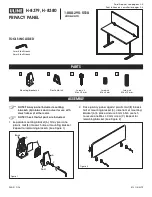
The Jitter measurements menu allows the user to measure and analyze received signal jitter. The measurement example is shown above (the vertical grid
spacing is 2.0 UIpp). The red bar indicates Max. peak jitter during testing and the yellow bar indicates the current peak jitter.
Setup
Configure the following settings before starting the test:
Filter:
HP1+LP or HP2+LP. The frequency for each filter varies depending on the setup mode (E1/E3, DS1/DS3). Frequency ranges for each filter and
setup mode are listed as follows:
E1: HP1+LP (20Hz to 100KHz); HP2+LP (18 Hz to 100KHz)
E3: HP1+LP (100Hz to 800KHz); HP2+LP (10KHz to 800KHz)
DS1: HP1+LP (10Hz to 40kHz); HP2+LP (8kHz to 40kHz)
DS3: HP1+LP (10Hz to 400kHz); HP2+LP (30kHz to 400kHz)
Generator:
ON or OFF
Frequency:
2 Hz to 10,000 Hz for E1(2M) options, 2 Hz to 800,000 Hz for E3 (34M) options. 2 Hz to 40,000 Hz for DS1 (1.5M) options, 2 Hz to 400,000
Hz for DS3(45M) options.
Amplitude:
Enter the amplitude at which peak to peak jitter generation occurs. See O.172 for the ITU recommendation on minimum jitter generation.
Press
Start
to start measurements.
Results
Results are displayed for the current jitter value and maximum jitter value during measurement.
13.2 Max Jitter Tolerance (MTJ)
Jitter Tolerance or jitter accommodation is defined in terms of the sinusoidal jitter amplitude which causes a designated error when applied to digital equipment
input. Jitter tolerance is a function of applied jitter's amplitude and frequency. Equipment must pass the lower limit of maximum jitter tolerance, which is specified
in ITU-T G.823, G.824, and G.825 standards.
The unit will transmit jitter from point-to-point or low to high frequency at different amplitudes to determine where errors occur. This is known as maximum jitter
tolerance (MTJ).
Defects and Anomalies Check
The Max Jitter Tolerance feature checks the health of the incoming signal prior to starting the test. If any alarms or errors are detected, the test set will notify the
user that the test cannot be performed and present configuration suggestions to correct the problem.
Error Message: Configuration Suggestions
TX300S_e-manual_D07-00-064P_RevA00
Содержание VePAL TX300M
Страница 1: ...TX300S_e manual_D07 00 064P_RevA00...
Страница 12: ...23 0 About VeEX Go back to top TX300S_e manual_D07 00 064P_RevA00...
Страница 29: ...Go back to top Go back to TOC TX300S_e manual_D07 00 064P_RevA00...
Страница 47: ...Go back to top Go back to TOC TX300S_e manual_D07 00 064P_RevA00...
Страница 58: ...Go back to top Go back to TOC TX300S_e manual_D07 00 064P_RevA00...
Страница 61: ...Tx Structure Setup Graphical Mode Tx Payload Setup TX300S_e manual_D07 00 064P_RevA00...
Страница 67: ...Tx Structure Setup Text Mode Tx Structure Setup Graphical Mode TX300S_e manual_D07 00 064P_RevA00...
Страница 71: ...Go back to top Go back to TOC TX300S_e manual_D07 00 064P_RevA00...
Страница 92: ...TX300S_e manual_D07 00 064P_RevA00...
Страница 126: ...TX300S_e manual_D07 00 064P_RevA00...
Страница 182: ...Go back to top Go back to TOC TX300S_e manual_D07 00 064P_RevA00...
Страница 220: ...Pattern Setup Results Errors Alarms TX300S_e manual_D07 00 064P_RevA00...
Страница 225: ...Multi Call B Channel Map Multi Call List Using ReVeal MTX300 TX300S_e manual_D07 00 064P_RevA00...
Страница 260: ...TX300S_e manual_D07 00 064P_RevA00...
Страница 261: ...Go back to top Go back to TOC Errors Alarms Page 2 TX300S_e manual_D07 00 064P_RevA00...
Страница 315: ...RFC 2544 Results Throughput Summary Table RFC 2544 Results Throughput Test Log Table TX300S_e manual_D07 00 064P_RevA00...
Страница 317: ...RFC 2544 Results Latency Jitter Graphical RFC 2544 Results Latency Jitter Summary TX300S_e manual_D07 00 064P_RevA00...
Страница 369: ...OAM LMM Parameters OAM Service DMM OAM DMM Message TX300S_e manual_D07 00 064P_RevA00...
Страница 374: ...Go back to top Go back to TOC TX300S_e manual_D07 00 064P_RevA00...
















































